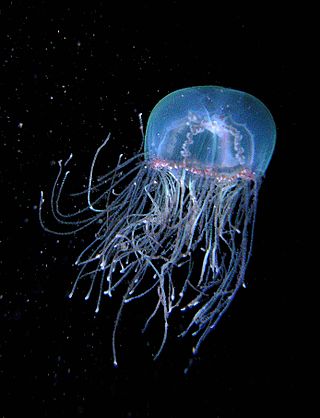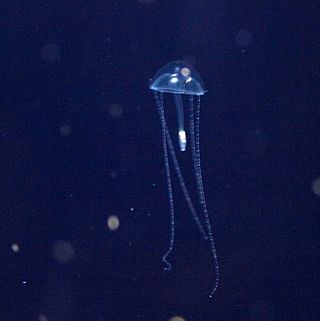
The Atlantic sea nettle, also called the East Coast sea nettle in the United States, is a species of jellyfish that inhabits the Atlantic coast of the United States. Historically it was confused with several Chrysaora species, resulting in incorrect reports of C. quinquecirrha from other parts of the Atlantic and other oceans. Most recently, C. chesapeakei of estuaries on the Atlantic coast of the United States, as well as the Gulf of Mexico, was only fully recognized as separate from C. quinquecirrha in 2017. It is smaller than the Pacific sea nettle, and has more variable coloration, but is typically pale, pinkish or yellowish, often with radiating more deeply colored stripes on the exumbrella, especially near the margin.

Gonionemus is a genus of hydrozoans that uses adhesive discs near the middle of each tentacle to attach to eelgrass, sea lettuce, or various types of algae instead of swimming. They are small and hard to see when hanging onto swaying seaweed. Nevertheless, they are capable of swimming when necessary. The bell is transparent, revealing the four orange to yellowish-tan gonads that lie along most of the length of the four radial canals. The pale yellow manubrium has four short, frilly lips. Up to 80 tentacles line the bell margin, with about an equal number of statocysts. Copepods are a favored prey.

Craspedacusta sowerbii or peach blossom jellyfish is a species of freshwater hydrozoan jellyfish, or hydromedusa cnidarian. Hydromedusan jellyfish differ from scyphozoan jellyfish because they have a muscular, shelf-like structure called a velum on the ventral surface, attached to the bell margin. Originally from the Yangtze basin in China, C. sowerbii is an introduced species now found throughout the world in bodies of fresh water.

Aequorea forskalea is a species of hydrozoan in the family Aequoreidae. Discovered in 1810 by Péron and Lesueur, A. forskalea was initially found in coastal to offshore waters of the Mediterranean Sea. This species is commonly referred to as the many-ribbed jellyfish. The species is often mixed up with some other members of the genus due to some similarities including the capability of bioluminescence.

The flower hat jelly is a species of hydromedusa in the hydrozoan family Olindiidae. Although they look like a jellyfish, they actually belong in the class Hydrozoa, while true jellyfish belong in class Scyphozoa. Flower hat jellies occur in the northwestern Pacific off central and southern Japan, and South Korea's Jeju Island.. The adult form of the flower hat jelly only lives a few months and is typically seen from December to July, with peaks in April and May. During the day they rest on the bottom, often among rocks or algae, but at night they float up to hunt for their prey, typically small fish.

Olindias phosphorica, or cigar jellyfish, is a species of hydrozoan from the central and eastern Atlantic and the Mediterranean Sea. The Mediterranean sea is a predominantly warm body of water, thus O. phosphorica is a warm-water Jellyfish. Global warming has facilitated the proliferation of the species throughout the Mediterranean sea.

Narcomedusae is an order of hydrozoans in the subclass Trachylinae. Members of this order do not normally have a polyp stage. The medusa has a dome-shaped bell with thin sides. The tentacles are attached above the lobed margin of the bell with usually a gastric pouch above each. There are no bulbs on the tentacles and no radial canals. Narcomedusans are mostly inhabitants of the open sea and deep waters. They can be found in the Mediterranean in large numbers.

Cydippida is an order of comb jellies. They are distinguished from other comb jellies by their spherical or oval bodies, and the fact their tentacles are branched, and can be retracted into pouches on either side of the pharynx. The order is not monophyletic, that is, more than one common ancestor is believed to exist.

Epiactis is a genus of sea anemones in the family Actiniidae. There are about nineteen recognised species and the type species is Epiactis prolifera.

Pandeidae is a family of hydroids in the class Hydrozoa. Like other jellyfish there is usually a mature medusa form which is pelagic and reproduces sexually and a hydroid or polyp form which is often benthic and reproduces asexually by budding.

Aeginidae is a family of hydrozoans in the order Narcomedusae. The family comprises 6 genera and 8 species.

Cuninidae is a family of hydrozoans in the order Narcomedusae. They have dome-shaped bells and tentacles set above the undulating margin of the bell. Their gastric pouches contain the gonads situated in line with the tentacles, the number of pouches being the same as the number of tentacles. The pouches do not extend below the points of origin of the primary tentacles. Members of some genera have a peripheral canal system and others do not. No radial canals or secondary tentacles are present.

Bathykorus bouilloni is a species of hydrozoan first described in 2010. It is a deep-sea species found in the Arctic Ocean, and appears to be common at depths below 1,000 m (3,300 ft). It is the only species in the monotypic genus Bathykorus. The genus name comes from the Greek bathy meaning "deep" and korus meaning "helmet", referring to the depth at which this species is found and to the shape of the bell. Its helmet-like appearance bears a resemblance to the helmet of Darth Vader, giving it the nickname Darth Vader jellyfish. The specific name is in honour of Dr. Jean Bouillon, (1926–2009), a marine zoologist.

Limnomedusae is an order of hydrozoans.

Olindiidae is a family of hydrozoans in the order Limnomedusae. They have a polyp phase and a medusa phase. The polyps are generally small (1 mm) and solitary, but a few species are colonial. They have a varying number of tentacles and can reproduce by budding. In the largest species, the medusae can grow to 15 cm (6 in). Centripetal canals may be present or absent and the radial canals are unbranched. The gonads are beside the radial canals, except in Limnocnida, where they are on the manubrium. The fertilised eggs develop into planula larvae which become polyps. These multiply asexually or can bud off medusae. In some species, medusae are only produced when the water temperature exceeds a certain level. Most species are marine, but several can also be found in brackish water and a few, notably Craspedacusta and Limnocnida, are found in fresh water.
Vallentinia gabriellae, the hitch-hiking jellyfish, is a species of small, inconspicuous hydrozoan in the family Olindiidae. It is endemic to a few isolated parts of the western Atlantic Ocean. It is elusive in the wild but sometimes makes its appearance unexpectedly in seawater cultures of other organisms in the laboratory.

Galaxea is a genus of colonial stony corals in the family Euphylliidae. Common names include crystal, galaxy, starburst and tooth coral. They are abundant on reefs in the Indo-Pacific region and the Red Sea. They are found in water less than 20 metres (66 ft) deep and favour turbid sites. They are sometimes kept in reef aquaria.

Bartholomea annulata is a species of sea anemone in the family Aiptasiidae, commonly known as the ringed anemone or corkscrew anemone. It is one of the most common anemones found on reefs in the Caribbean Sea.

Liriope is a genus of hydrozoan in the family Geryoniidae. It contains only one species, Liriope tetraphylla.

Aglantha digitale is a species of hydrozoan in the family Rhopalonematidae. It is found in the Arctic and sub-Arctic where it is one of the most common jellyfish. It is unusual in having both a slow swimming action, through pulsating its bell, and a rapid escape response.
















